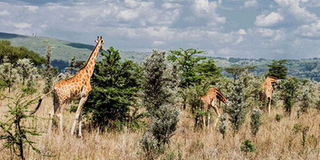Why wildlife is critical for human existence

Giraffes graze at Ruma National Park in Homa Bay on April 14, 2019. Biodiversity conservation needs to be an integral part of the government’s agenda as it cuts across other economic sectors. PHOTO | FILE | NATION MEDIA GROUP
What you need to know:
- Some of the protected areas, such as Mt Kenya, Mt Elgon, Aberdares and Chyulu Hills, are also among the most significant water towers in the country.
- A more inclusive and multidisciplinary approach to national planning and development to ensure development does not undermine biodiversity is needed.
In the wake of a report by the United Nations on the decline of biodiversity, we are inclined to pause and reflect.
The Intergovernmental Science Policy Platform on Biodiversity and Ecosystem Services (IPBES) study shows a million species are at risk of extinction due to human activity.
Many a time, most humans live as though the planet is ours for the taking.
Some scientists even want to rename this chapter in Earth’s history as “Anthropocene”, or the Age of Humans, to highlight the fact that even though humans are less than one per cent of all life on the planet, we have taken it upon ourselves to destroy 83 per cent of all wild animals and half of the plants on it.
Besides its significant contribution to Kenya’s economy through tourism, wildlife plays an important role in balancing an ecosystem and provides stability to different natural processes of nature like rainfall (transpiration from plants), changing of temperature (heat evolution by animals) and fertility of soil (making of manure by earthworms).
PROTECTED AREAS
Wild animals are intrinsically valuable. They are genetically unique and cannot be exchanged for another individual of the same species.
Wildlife is our national heritage with most of our emblems — including the court of arms, currency and several county flags — bearing images of animals.
From a cultural perspective, some communities use them as totems.
Most of the wildlife estate is in arid and semi-arid areas, where livestock keeping is the other predominant form of land use. These dry areas constitute two-thirds of Kenya’s land mass.
Some of the protected areas, such as Mt Kenya, Mt Elgon, Aberdares and Chyulu Hills, are also among the most significant water towers in the country.
Most wildlife landscapes face challenges of degradation and fragmentation through human encroachment.
Land use practices that are incompatible with biodiversity conservation are decimating habitats and wildlife species.
CONFLICT
Infrastructure development through protected areas, though good for economic development, compromises vital landscapes as well as their connectivity to key dispersal areas that wildlife require.
It’s this decline in space for wildlife that is responsible for the escalation of human-wildlife conflict, which has become the biggest threat to wildlife conservation and coexistence with Man, at least for the larger species such as elephants, lions and hippo.
The smaller species are poached for subsistence to feed largely urban and unsuspecting populations.
These challenges will increase in magnitude if left unchecked, to the detriment of the nation’s biodiversity. However, the report tells us that it is not too late to make a difference.
CONSERVATION
Through transformative change, nature can conserved, restored and used sustainably.
Biodiversity conservation needs to be an integral part of the government’s agenda as it cuts across other economic sectors.
Even the ‘Big Four Agenda’ could negatively affect the environment if not well executed.
Achieving national development goals should not be the death knell of the ‘Big Five’, figuratively the flag bearers of Kenya’s wildlife and their habitat. Development and conservation are, and should, not be mutually exclusive.
A more inclusive and multidisciplinary approach to national planning and development to ensure development does not undermine biodiversity is needed.
Mr Isiche is the regional director - East Africa, International Fund for Animal Welfare (ifaw) [email protected]




